|
1/26/2015 Home Practice: Yoga Nidra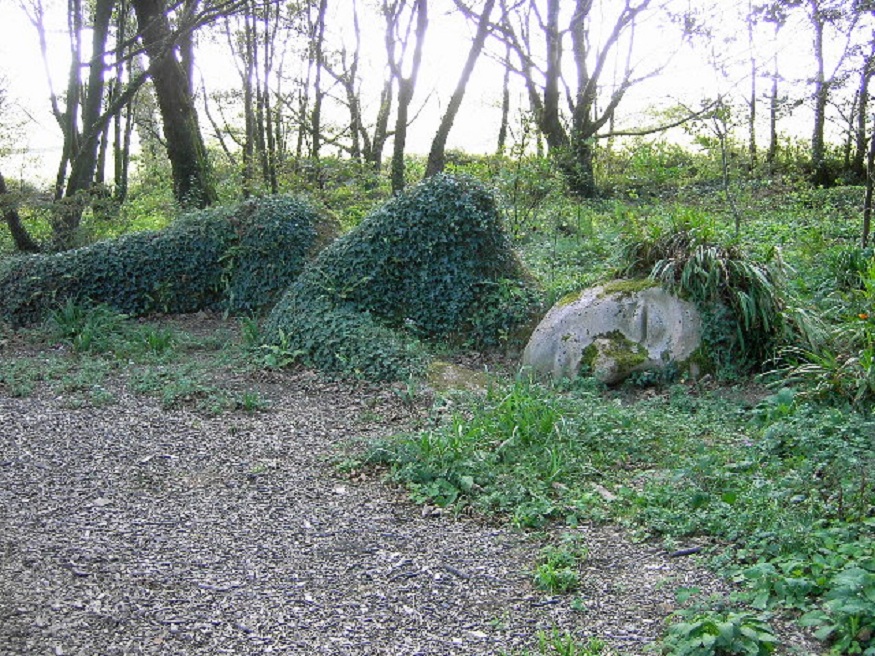 Yoga Nidra is a systematic method of guided relaxation that has a profound effect on the body, mind and emotions. During the practice, you lie down in a comfortable position and are asked to remain awake and relaxed. The instructor will guide you through various stages of deeper relaxation where you turn your awareness to the inner landscape, away from external experiences. During Yoga Nidra, you will enter the hypnagogic state between wakefulness and dreaming which we usually only spend a few minutes in daily as we are drift off to sleep at night. Here, the effect on the mind can be very powerful because as the mind becomes more relaxed, it also becomes more receptive. The practice can help us to increase our creativity, aid in memory retention, reduce stress, overcome past traumas, release our samskaras (mental impressions), cultivate our witness consciousness, and more fully embody our true nature. It is best to practice yoga nidra in a quiet, comfortable room in your home where you can rest undisturbed for 30-40 minutes. Unplug your telephone, turn off your cell phone, television and radio. Some amount of background noise is to be expected for those of us living in an urban environment so absolute quiet is NOT necessary. Make yourself as comfortable as possible lying on your back. Support your head, the backs of the knees and the heels with bolsters or rolled blankets (the heels should not touch the floor). You may want to cover your eyes with a bandana or scarf but avoid a flax-filled eyebag as these are a bit to heavy for the eyes for this length of time. Also, make sure that you are warm, the body temperature will drop a few degrees due to the stillness of the practice, so a light blanket is a nice addition to your Yoga Nidra set-up. The most important part in preparing for Yoga Nidra is the physical set-up of your space, but you also need to be in the mood to find deep relaxation. Sometimes the brain will be a whirlwind of thoughts and the emotions will be in turmoil. At these times, take a few minutes to practice some gentle asana warm-ups, or grounding mudras to be sure that you are present for the practice. Do not worry if you fall asleep or miss some of what is said, just continue to listen to my voice which will help to anchor you into the hypnagogic state of consciousness where the witness to all of our experiences resides.
1 Comment
1/19/2015 Home Practice: In the EveningIn the evening the home yoga practice centers around poses and breathing techniques that ratchet down the stress response in the body. When we are awake, the nervous system is on high alert and we are constantly aware of sensory perceptions in order to maintain ourselves at work and at home. When it is time to rest sometimes the nervous system is still engaged at a very high level. These practices will reduce the fight or flight response and begin to induce the relaxation response to prepare the body and mind for sleep.  Dwimukham Mudra Hold the hands open in front of the abdomen with the palms facing upwards. Touch the tips of the ring and pinkie fingers together. Benefits: Reduces stress and blood pressure Benefits: Helpful for anxiety and insomnia  Reclining Flow Supta Vinyasa Begin lying on the back with the legs straight and arms extended over the head, take an inhale to prepare. Exhale and draw the right knee into the chest, holding it with the right hand. Inhale draw the right knee out to the right side with the right hand, left hand in cactus on the floor. Exhale and cross the right knee over to the left side of the body with the left hand, right hand in cactus on the floor. Inhale back to the center and extend the right leg up toward the ceiling, holding behind thigh with the clasped hands. Exhale draw the right knee to the chest. Inhale extend the leg to the floor and the arms overhead. Exhale and repeat the entire sequence with left leg. Therapeutics: Opens the major joints of the lower body and stretches the legs, hips, low back and shoulders  Reclining Thumb to Big Toe Pose I Supta Padangusthasana I Lie on the back with the legs straight. Draw your right knee into your chest and lengthen the left leg onto the floor. Wrap a strap around the ball of your right foot and extend the leg into the air. Reach the hands up the strap until the elbows are straight but the shoulders are still grounded. Hold for 10-20 breaths. Therapeutics: Stretches the hamstrings, calves, buttock; also releases tension in the lower back.  Reclining Thumb to Big Toe Pose II Supta Padangusthasana II Lie on the back with the legs straight. Place a block on the outside of the right hip. Wrap strap around the ball of the right foot, extend the leg and hold the strap in just the right hand. Externally rotate your leg and as you exhale , lower the leg directly out to the side so that the outer thigh rests on the block. Extend the foot into the strap and reach the left arm out to the side keeping the left hip on the floor. To release, use the inner thigh to draw the leg up to center. Hold for 10-20 breaths then release to center. Therapeutics: Stretches the hamstrings, calves, inner thigh, outer hip and buttock; also releases tension in the lower back. 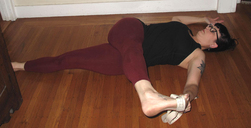 Reclining Thumb to Big Toe Pose III Supta Padangusthasana III Lie on the back with the legs straight. Place a block on the outside of the right hip. Wrap strap around the ball of the right foot, extend the leg and hold the strap in the left hand and slowly bring the leg across the body as you twist the lower body, keeping the shoulders on the floor and the right arm out to the side. To release, drop the right hip into the floor and allow the leg to follow. Hold for 10-20 breaths then release to center. Therapeutics: Stretches the outer hamstrings, calves, outer hip, buttock; also releases tension in the lower back.  Supported Easy Seated Pose Salamba Sukhasana Sit on edge of folded blanket in front of a chair with legs crossed. Inhale to lengthen the spine and place a bolster vertically in lap. Lean forward on to the bolster which is supported by the chair. Turn head to one side and rest arms in chair seat. Therapeutics: Gently stretches hips and back, helps to release tension in the back while surrendering the mind.  Soft Abdominal Breathing Adhama Svasa Begin lying down with head and knees supported. Rest hands on abdomen and feel movement of abdomen. Notice fullness in the belly when you inhale and the relaxation in the belly when you exhale. Imagine a balloon in the lower belly that inflates when you inhale and deflates when you exhale and concentrate on the feeling of breath dropping down into that part of your torso with soft transitions between inhaling and exhaling. Emphasize a soft open belly so that the abdominal organs can expand as the diaphragm descends. Repeat for 1-3 minutes. Benefits: Activates relaxation response, opens Svadhisthana Chakra Practice Tips: Use when feeling overwhealmed or anxious 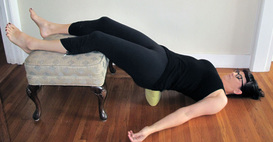 Instant Maui Lie on back with legs in the seat of a chair. Lift pelvis off floor and place block or a folded blanket under pelvis. Place arms away from sides and palms up. Rest 15 minutes. Therapeutics: Induces relaxation response, reduces swelling of feet and legs, relaxes lower back Contraindications: High Blood Pressure 1/12/2015 Home Practice: In the AfternoonBy the afternoon, many of us are feeling lethargic and exhausted. This is the perfect time to find a quiet place for some restorative yoga. Even if you work at an office, close your door or find a personal phone call room and give yourself a 20 minute yoga break. These three restoratives are paired with a mudra and a pranayama practice that combine to provide a short oasis for stress and leave you feeling calm yet awake and ready to face the rest of your day. Enjoy! 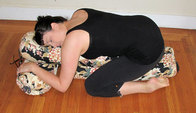 Supported Child's Pose Salamba Balasana Kneel straddling a long bolster. Place a second bolster over first with end of bolster in front of your low abdomen. A third bolster can go under the far end of the second bolster or use a folded blanket or block to support under it. Extend front of body over second bolster and rest forearms on bolster with hands in Adhi Mudra. Rest up to 5 minutes. Therapeutics: Creates a calm, grounded space to get away from the demands of daily life  Adhi Mudra Make a soft fist with the thumb tucked inside. Turn palms down and rest on knees. Benefits: Calms nervous system, facilitates breath in lower abdomen Practice Tips: Use when feeling anxious or insecure Contraindications: Low blood pressure Exhale Retention Rechaka Kumbhaka Inhale through nostrils, then exhale completely through nostrils and pause after the exhalation holding the breath out. The length of the pause should be comfortable to maintain. Benefits: Calming, grounding, quiets the mind  Reclining Bound Angle Pose Supta Baddha Konasana Sit in front of two long-fold blankets or a bolster parallel to mat. Place soles of feet together and let knees move apart resting on blocks or bolster. Place looped strap around back of pelvis between thighs and over outside edge of feet to help lengthen low back. Lie back over bolster and place blanket under head. Place hands in Urdhva Merudanda Mudra. Rest 5-15 minutes, then release. Therapeutics: Relaxes floor of pelvis, opens belly and chest, creates a sense of safety and calm 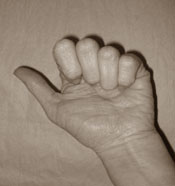 Urdhva Merudanda Mudra Make a soft fist and extend thumb away from palm; Lightly press fingernails into the palm; rest back of hands on thighs with thumbs pointing away from each other. Benefits: Energizes nervous system Practice Tips: Use when feeling lethargic or depressed Contraindications: High blood pressure Elevator Breath Imagine that the breath is like an elevator car that could travel up and down the length of the spine. Imagine that the elevator shaft is aligned along sushumna nadi, the energetic channel that runs from the perineum in the pelvic floor to the crown of the head. Upwards Variation: As you inhale, imagine the breath travelling down the spine from crown to pelvic floor. As you exhale, imagine the breath travelling upwards from the pelvic floor to the crown of the head. Practice for 10-20 rounds of breath, then allow the breath to return to normal. Benefits: Creates a sense of lift on the inhalation and grounding on the exhalation, lengthens both inhale and exhale.  Instant Maui Lie on back with legs in the seat of a chair. Lift pelvis off floor and place block or a folded blanket under pelvis. Place arms away from sides and palms up with hands in Pushan Mudra. Rest 15 minutes. Therapeutics: Induces relaxation response, reduces swelling of feet and legs, relaxes lower back Contraindications: High Blood Pressure 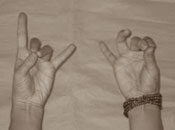 Pushan Mudra Right Hand: Touch tips of thumb, index & middle fingers together, extend all others. Left Hand: Touch tips of thumb, middle & ring fingers together, extend all others. Rest hands with palms up. Benefits: Activates relaxation response Practice Tips: Use when you feel like you are internalizing the stressors in your life Alternate Nostril Breath
Nadi Shodhana Inhale through right nostril, exhale through left nostril, inhale through left nostril, exhale through right nostril, repeat for 10 rounds at a time, monitoring the effects. Psychic Method: Breathe in and out through alternate nostrils using your imagination. This method has a subtler affect but is easier to do lying down. Benefits: Balances the sympathetic nervous system (fight or flight) and the parasympathetic nervous system (rest and digest), increases communication between the right and left hemispheres of the brain. |
Index:Archives:
September 2022
I attend Cheryl's class regularly and feel that my practice has improved immensely over the past few years due to her expert coaching. Her teaching style is clear and compassionate and her previous experience in teaching adults is evident in her organized approach and easy to understand instructions. I also appreciate that Cheryl not only teaches us about how to correctly position ourselves, but also touches on many aspects of yoga philosophy, which in turn has deepened my personal practice and heightened my awareness of the connection between mind and body, breath and relaxation. |

 RSS Feed
RSS Feed
